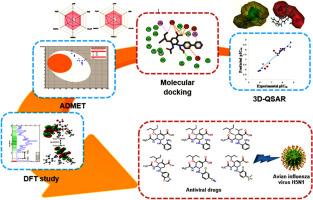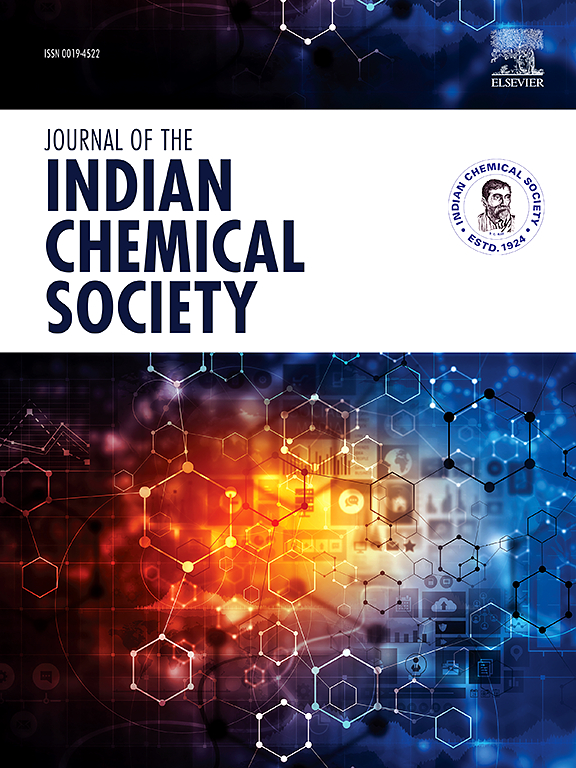Novel therapeutic agents for H5N1 influenza virus through 3D-QSAR, molecular docking, ADMET prediction, and DFT based global reactivity descriptors
IF 3.2
4区 化学
Q2 CHEMISTRY, MULTIDISCIPLINARY
引用次数: 0
Abstract
Avian influenza is a severe respiratory disease that can cause catastrophic outbreaks in domestic poultry and wild birds as well as significant risks to people. This has motivated many researchers to develop new, effective neuraminidase (NA) inhibitors to treat this serious infection. In this context, this study aims to develop new potential NA inhibitors using five computational methods. A three-dimensional quantitative structure-activity relationship (3D-QSAR) comparative molecular similarity indices analysis (CoMSIA) was performed on a set of N-substituted Oseltamivir derivatives as anti-influenza agents. As a result, the best CoMSIA model was robust and predictive (R2 = 0.966, Q2 = 0.772, and = 0.721). Based on the contour map analysis, 17 new NA inhibitors with high-predicted inhibitory activity were developed. Molecular docking was used to discover the binding modes and interactions between the 17 newly designed NA compounds and the corresponding NA protein. Based on the absorption, distribution, metabolism, elimination, and toxicity (ADMET) properties, the compounds C10, C11, C12, C15, C16, and C17 have good drug-likeness and pharmacokinetics properties and could be new promising anti-influenza drugs. The six leading compounds further went through biological activity spectra prediction and quantum method density functional theory (DFT) study, which confirmed the trends and the utility of 3D-QSAR CoMSIA and molecular docking in developing new NA inhibitors.

通过三维-QSAR、分子对接、ADMET 预测和基于 DFT 的全局反应性描述符研究 H5N1 流感病毒的新型治疗药物
禽流感是一种严重的呼吸道疾病,可导致家禽和野生鸟类爆发灾难性疫情,并对人类造成严重危害。这促使许多研究人员开发新的、有效的神经氨酸酶(NA)抑制剂来治疗这种严重的感染。在此背景下,本研究旨在利用五种计算方法开发新的潜在 NA 抑制剂。研究人员对一组作为抗流感药物的 N-取代奥司他韦衍生物进行了三维定量结构-活性关系(3D-QSAR)比较分子相似性指数分析(CoMSIA)。结果表明,最佳 CoMSIA 模型具有稳健性和预测性(R2 = 0.966,Q2 = 0.772,Rpred2 = 0.721)。根据等高线图分析,开发出 17 种具有高预测抑制活性的新 NA 抑制剂。通过分子对接发现了17种新设计的NA化合物与相应NA蛋白的结合模式和相互作用。根据吸收、分布、代谢、消除和毒性(ADMET)特性,C10、C11、C12、C15、C16和C17化合物具有良好的药物相似性和药代动力学特性,可以成为有前途的抗流感新药。这六个主要化合物还进一步进行了生物活性谱预测和量子方法密度泛函理论(DFT)研究,证实了三维-QSAR CoMSIA和分子对接在开发新的NA抑制剂方面的趋势和作用。
本文章由计算机程序翻译,如有差异,请以英文原文为准。
求助全文
约1分钟内获得全文
求助全文
来源期刊
CiteScore
3.50
自引率
7.70%
发文量
492
审稿时长
3-8 weeks
期刊介绍:
The Journal of the Indian Chemical Society publishes original, fundamental, theorical, experimental research work of highest quality in all areas of chemistry, biochemistry, medicinal chemistry, electrochemistry, agrochemistry, chemical engineering and technology, food chemistry, environmental chemistry, etc.

 求助内容:
求助内容: 应助结果提醒方式:
应助结果提醒方式:


